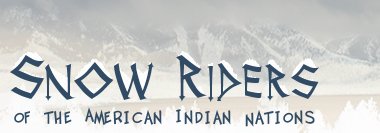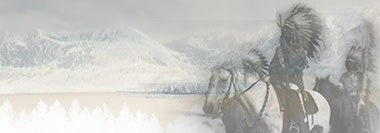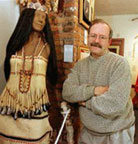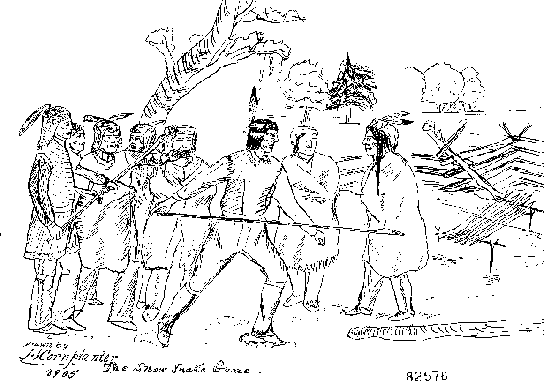 |
 |
ABENAKI SPORTS Abenaki sports consisted of a number of different "games". However among the Abenaki, the spirit of the competition was more important than winning or losing. One competitor would never embarrass another during a game. For example, if one runner was far ahead of his competitor he would slow down and make the race closer as to not embarrass the other runners.  Frederick Wiseman's (Abenaki Professor at Johnson State College), "Voice of the Dawn" speaks of their tradition of first sharing a sport before sitting down to do business with other bands or tribes. Photo 1: Fred Wiseman at the Abenaki Cultural Museum, Swanton Photo 2: Lacrosse Stick, one of many types, some are still handmade Some of the sporting events that took place in Abenaki villages were running events and archery which began at a young age with blunt arrows. But one of the largest sporting events was Babaskwahamawogan -Lacrosse. Entire villages competed in games which could be made up of men, women or co-ed. The stick was usually made from a crooked piece of ash or hickory similar in shape to a bishop's crosier which is how the game received it's modern day name from the French 'La Crosse. In fact Iroquois Faithkeeper, and Grand Master Lacrosse player, Oren Lyons, said that Lacrosse was and is still used as a spiritual healing event, and it was a lacrosse coach that used most of the elements to practice in a gym in winter, which united with the S. American tribal courts and rubber balls to became basketball. (basketball info from Smithsonian archives)  The stick had a finely netted rawhide basket similar to that of a fish net and was about 30 inches in length. Each stick was considered a very
important individual possession made by its intended user and often adorned with carved or burned designs. The ball called a
babaskwahamawogan was made usually from a leather disk about 9 inches in diameter and filled with Moose hair. The game is played in an open field
or meadow close to the village. Two goals are made at either end consisting of marked rings or shallow holes.
The stick had a finely netted rawhide basket similar to that of a fish net and was about 30 inches in length. Each stick was considered a very
important individual possession made by its intended user and often adorned with carved or burned designs. The ball called a
babaskwahamawogan was made usually from a leather disk about 9 inches in diameter and filled with Moose hair. The game is played in an open field
or meadow close to the village. Two goals are made at either end consisting of marked rings or shallow holes.Prior to the start of the game the competitors determine what the winning score will be, but often times the game was played until one side became too tired and gave up. The referee takes a wooden chip called a piakahiga and spits on one side then flips it to determine which side will get the ball first. Friendly games ended with very few injuries, however, games that were played to settle disagreements were serious competition and often times resulted in major injuries as there were no specific rules or fouls. (The First Americans also invented the roots of team sports - baseball, field and ice hockey and soccer as a substitute for war) SNOW SNAKE... A winter game played by the Abenaki was called the snow snake. Most Abenaki snow snakes were carved pieces of would approximately 18-24 inches long. Among the numerous shapes are two main varieties, the spoon mouth and the snake head. If someone wanted to start a game of snow snake he would run through the village calling out that a game would be played. Soon all those who were interested in playing would join him each bringing their own snow snakes. The game was played at a place with a hard flat crust of snow so that the snow snakes would glide easily on top. Each player would line up and take a turn throwing his or her snow snake. The snow snake was thrown in a motion similar to that of skipping a stone on a lake. Once your snow snake stopped it would be upended to show how far it had gone. The snow snake that had gone the furthest was the winner. Sometimes the winner would win all the other snow snakes, he would then gather up all the snow snakes, yell out and toss them all into the air. Then the other players would rush to get their snow snake, or the one they thought was the best. ~ from Brian Chenevert, Abenaki  Illustration: Jesse Cornplanter sketched The Snow Snake Game in 1905 From the Cornplanter Collection New York Public Library Abenaki Bio Pages » Abenaki Bio Home » Abenaki Culture and History » Abenaki Basket Art » Famous Abenaki's |
Home | Photo Gallery | Nations/Ski Areas Mapped by State | Nations Directory | Ski Areas Directory | Events | Tributes | Snow/Earth Care
Entry Page | NA Olympic Bid | Shining Moments | Tribal Gifts | Miracles | Donations | Nations Bios | Site Credits | Site Map | Contact Us
Entry Page | NA Olympic Bid | Shining Moments | Tribal Gifts | Miracles | Donations | Nations Bios | Site Credits | Site Map | Contact Us
© Snow Riders of the American Indian Nations/ Native Voices. All Rights Reserved. This site is a world-wide collaboration.